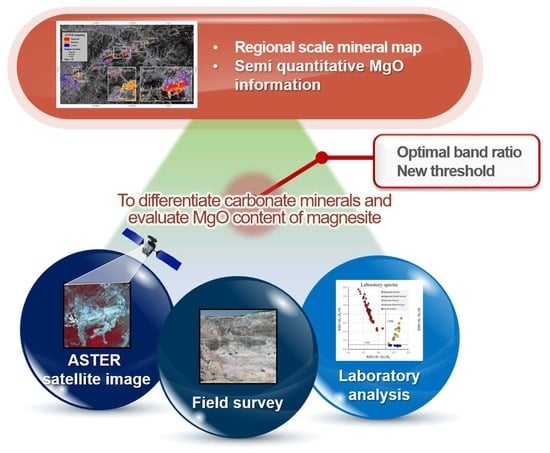Application of ASTER Data for Differentiating Carbonate Minerals and Evaluating MgO Content of Magnesite in the Jiao-Liao-Ji Belt, North China Craton
Abstract
:1. Introduction
2. Geology
3. Methods
3.1. Spectral Measurements and Chemical Analysis
3.2. ASTER Data and Pre-Processing
3.3. ASTER SWIR Band Ratios for Carbonate Minerals
4. Results
4.1. Thresholds for Magnesite, Dolomite, and Calcite
4.2. Band Ratio for Magnesium Oxide Content
5. Discussion
5.1. Band Ratio Assessment
5.2. Grade of Magnesite
6. Conclusions
Author Contributions
Funding
Institutional Review Board Statement
Informed Consent Statement
Data Availability Statement
Conflicts of Interest
References
- Mao, Y.C.; Xiao, D.; Cheng, J.F.; Jiang, J.H.; Ba, T.L.; Liu, S.J. Multigrades classification model of magnesite ore based on SAE and ELM. J. Sens. 2017, 2017, 9846181. [Google Scholar] [CrossRef] [Green Version]
- Gaffey, S.J. Spectral reflectance of carbonate minerals in the visible and near infrared (0.35–2.55 um): Anhydrous carbonate minerals. J. Geophys. Res.-Solid Earth 1987, 92, 1429–1440. [Google Scholar] [CrossRef]
- Clark, R.N.; King, T.V.V.; Klejwa, M.; Swayze, G.A.; Vergo, N. High spectral resolution reflectance spectroscopy of minerals. J. Geophys. Res.-Solid Earth 1990, 95, 12653–12680. [Google Scholar] [CrossRef] [Green Version]
- Gaffey, S.J. Spectral reflectance of carbonate minerals in the visible and near infrared (0.35–2.55 microns): Calcite, aragonite, and dolomite. Am. Miner. 1986, 71, 151–162. [Google Scholar]
- Kurz, T.H.; Dewit, J.; Buckley, S.J.; Thurmond, J.B.; Hunt, D.W.; Swennen, R. Hyperspectral image analysis of different carbonate lithologies (limestone, karst and hydrothermal dolomites): The Pozalagua Quarry case study (Cantabria, North-west Spain). Sedimentology 2012, 59, 625–643. [Google Scholar] [CrossRef]
- Yamaguchi, Y.; Kahle, A.B.; Tsu, H.; Kawakami, T.; Pniel, M. Overview of advanced spaceborne thermal emission and reflection radiometer (ASTER). IEEE Trans. Geosci. Remote Sens. 1998, 36, 1062–1071. [Google Scholar] [CrossRef] [Green Version]
- Abrams, M.; Yamaguchi, Y. Twenty years of ASTER contributions to lithologic mapping and mineral exploration. Remote Sens. 2019, 11, 1394. [Google Scholar] [CrossRef] [Green Version]
- Rowan, L.C.; Mars, J.C. Lithologic mapping in the Mountain Pass, California area using Advanced Spaceborne Thermal Emission and Reflectance Radiometer (ASTER) data. Remote Sens. Environ. 2003, 84, 350–366. [Google Scholar] [CrossRef]
- Ninomiya, Y.; Fu, B.; Cudahy, T.J. Detecting lithology with Advanced Spaceborne Thermal Emission and Reflectance Radiometer (ASTER) multispectral thermal infrared radiance-at-sensor data. Remote Sens. Environ. 2005, 99, 127–139. [Google Scholar] [CrossRef]
- Mars, J.C.; Rowan, L.C. ASTER spectral analysis and lithologic mapping of the Khanneshin carbonatite volcano, Afghanistan. Geosphere 2011, 7, 276–289. [Google Scholar] [CrossRef] [Green Version]
- Ghorbani, A.; Honarmand, M.; Shahriari, H.; Hassani, M.J. Regional scale prospecting for non-sulphide zinc deposits using ASTER data and different spectral processing methods. Int. J. Remote Sens. 2019, 40, 8647–8667. [Google Scholar] [CrossRef]
- Beirami, M.R.; Tangestani, M.H. A new band ratio approach for discriminating calcite and dlomite by ASTER imagery in arid and semiarid regions. Nat. Resour. Res. 2020, 29, 2949–2965. [Google Scholar] [CrossRef]
- Sridhar, M.; Muthukumar, M. Spectral library for various rocks and minerals of Salem district: A comparative study and validation with ASTER data. In On a Sustainable Future of the Earth’s Natural Resources; Ramkumar, M., Ed.; Springer: Berlin, Germany, 2013; pp. 149–157. [Google Scholar]
- Ranganathan, P.C.; Siddan, A. Geospatial assessment of ultramafic rocks and ore minerals of Salem, India. Arab. J. Geosci. 2020, 13, 1095. [Google Scholar] [CrossRef]
- U.S. Geological Survey. Mineral Commodity Summaries 2020; U.S. Geological Survey: Reston, VA, USA, 2020; 200p.
- Kokaly, R.F.; Clark, R.N.; Swayze, G.A.; Livo, K.E.; Hoefen, T.M.; Pearson, N.C.; Wise, R.A.; Benzel, W.M.; Lowers, H.A.; Driscoll, R.L.; et al. USGS Spectral Library Version 7; U.S. Geological Survey Data Series 1035; U.S. Geological Survey: Reston, VA, USA, 2017; 61p.
- Li, Z.; Chen, B.; Yan, X. The Liaohe Group: An Insight into the Paleoproterozoic tectonic evolution of the Jiao–Liao–Ji Belt, North China craton. Precambrian Res. 2019, 326, 174–195. [Google Scholar] [CrossRef]
- Tang, H.-S.; Chen, Y.-J.; Santosh, M.; Zhong, H.; Wu, G.; Lai, Y. C–O isotope geochemistry of the Dashiqiao magnesite belt, North China Craton: Implications for the Great Oxidation Event and ore genesis. Geol. J. 2013, 48, 467–483. [Google Scholar] [CrossRef]
- Kim, C.W.; Ryu, J.M.; Ri, S.R.; Um, H.Y.; Seo, W.S.; Kim, Y.H.; Kim, J.H. Ore Deposits of Joseon (3); Science Encyclopedia Publisher: Pyongyang, Korea, 1991; 400p. [Google Scholar]
- Chang, R.; Liu, Y.; Li, W.; Gu, D. Deformation and rheological properties of Dashiqiao Formation of Liaohe Group in Hupiyu area, eastern Liaoning Province. Geol. J. 2019, 54, 804–818. [Google Scholar] [CrossRef]
- Chen, C.X.; Jiang, S.Y.; Cai, K.Q.; Ma, B. Metallogenic conditions of magnesite and talc deposits in early Proterozoic Mg-rich carbonate formations, eastern Liaoning province. Miner. Depos. 2003, 22, 166–176. [Google Scholar]
- Chen, C.X.; Ni, P.; Cai, K.Q.; Zhai, Y.S.; Deng, J. The minerogenic fluids of magnesite and talc deposits in the Paleoproterozoic Mg-rich carbonate formations in eastern Liaoning province. Geol. Rev. 2003, 49, 645–651. [Google Scholar]
- Jiang, S.-Y.; Chen, C.X.; Chen, Y.Q.; Jiang, Y.-H.; Dai, B.Z.; Ni, P. Geochemistry and genetic model for the giant magnesite deposits in the eastern Liaoning province, China. Acta Petrol. Sin. 2004, 20, 765–772. [Google Scholar]
- Zhang, Q. Early proterozoic tectonic styles and associated mineral deposits of the North China Platform. Precambrian Res. 1988, 39, 1–29. [Google Scholar] [CrossRef]
- Jeon, G.B.; Park, H.W.; Kim, J.N.; Yang, J.H.; Ri, S.R.; Jo, I.W.; Gang, I.S. Geology of Joseon; Science and Technology Publishing House: Pyongyang, Korea, 2011; 442p. [Google Scholar]
- Kim, Y.M.; Han, B.S.; Park, I.S.; Um, H.Y.; Paik, R.J.; Jeong, S.I.; Ri, M.C. Geology and Underground Resources; Education Book Publishing House: Pyongyang, Korea, 1988; 667p. [Google Scholar]
- Lee, G.; Shin, D.; Lee, S.; Koh, S.M.; Lee, B.H.; You, B.W.; Yoo, B.C. Ore genesis and tectonic implication of the Daeheung-Ryongyang magnesite deposits in the East Jiao-Liao-Ji Belt, North Korea. Lithos 2021, 106402, 400–401. [Google Scholar] [CrossRef]
- Duda, K.; Daucsavage, J.; Siemonsma, D.; Brooks, B.; Oleson, R.; Meyer, D.; Doescher, C. Advanced Spaceborne Thermal Emission and Reflection Radiometer (ASTER) Level 1 Precision Terrain Corrected Registered At-Sensor Radiance Product (AST_L1T): AST_L1T Product User’s Guide, Version 1.1. 2020. Available online: https://lpdaac.usgs.gov/products/ast_l1tv003/ (accessed on 14 June 2021).
- Adler-Golden, S.M.; Matthew, M.W.; Bernstein, L.S.; Levine, R.Y.; Berk, A.; Richtsmeier, S.C.; Acharya, P.K.; Anderson, G.P.; Felde, J.W.; Gardner, J.A.; et al. Atmospheric correction for short-wave spectral imagery based on MODTRAN4. In Engineering, and Instrumentation; SPIE’s International Symposium on Optical Science: Denver, CO, USA, 1999. [Google Scholar]
- Iwasaki, A.; Tonooka, H. Validation of a crosstalk correction algorithm for ASTER/SWIR. IEEE Trans. Geosci. Remote Sens. 2005, 43, 2747–2751. [Google Scholar] [CrossRef]
- Mars, J.C.; Rowan, L.C. Regional mapping of phyllic-and argillic-altered rocks in the Zagros magmatic arc, Iran, using Advanced Spaceborne Thermal Emission and Reflectance Radiometer (ASTER) data and logical operator algorithms. Geosphere 2006, 2, 161–186. [Google Scholar] [CrossRef]
- Son, Y.S.; Kang, M.K.; Yoon, Y.J. Lithological and mineralogical survey of the Oyu Tolgoi region, Southeastern Gobi, Mongolia using ASTER reflectance and emissivity data. Int. J. Appl. Earth Obs. Geoinf. 2014, 26, 205–216. [Google Scholar] [CrossRef]
- Son, Y.S.; Kang, M.K.; Yoon, Y.J. Pyrophyllite mapping in the Nohwa deposit, Korea, using ASTER remote sensing data. Geosci. J. 2014, 18, 295–305. [Google Scholar] [CrossRef]
- Crowley, J.K.; Brickey, D.W.; Rowan, L.C. Airborne imaging spectrometer data of the Ruby Mountains, Montana: Mineral discrimination using relative absorption band-depth images. Remote Sens. Environ. 1989, 29, 121–134. [Google Scholar] [CrossRef]
- Sabins, F.F. Remote sensing for mineral exploration. Ore Geol. Rev. 1999, 14, 157–183. [Google Scholar] [CrossRef]
- Son, Y.S.; Kim, K.E.; Yoon, W.J.; Cho, S.J. Regional mineral mapping of island arc terranes in southeastern Mongolia using multispectral remote sensing data. Ore Geol. Rev. 2019, 113, 103106. [Google Scholar] [CrossRef]
- Son, Y.S.; You, B.W.; Bang, E.S.; Cho, S.J.; Kim, K.E.; Baik, H.; Nam, H.T. Mapping alteration mineralogy in eastern Tsogttsetsii, Mongolia, based on the WorldView-3 and field shortwave-infrared spectroscopy analyses. Remote Sens. 2021, 13, 914. [Google Scholar] [CrossRef]

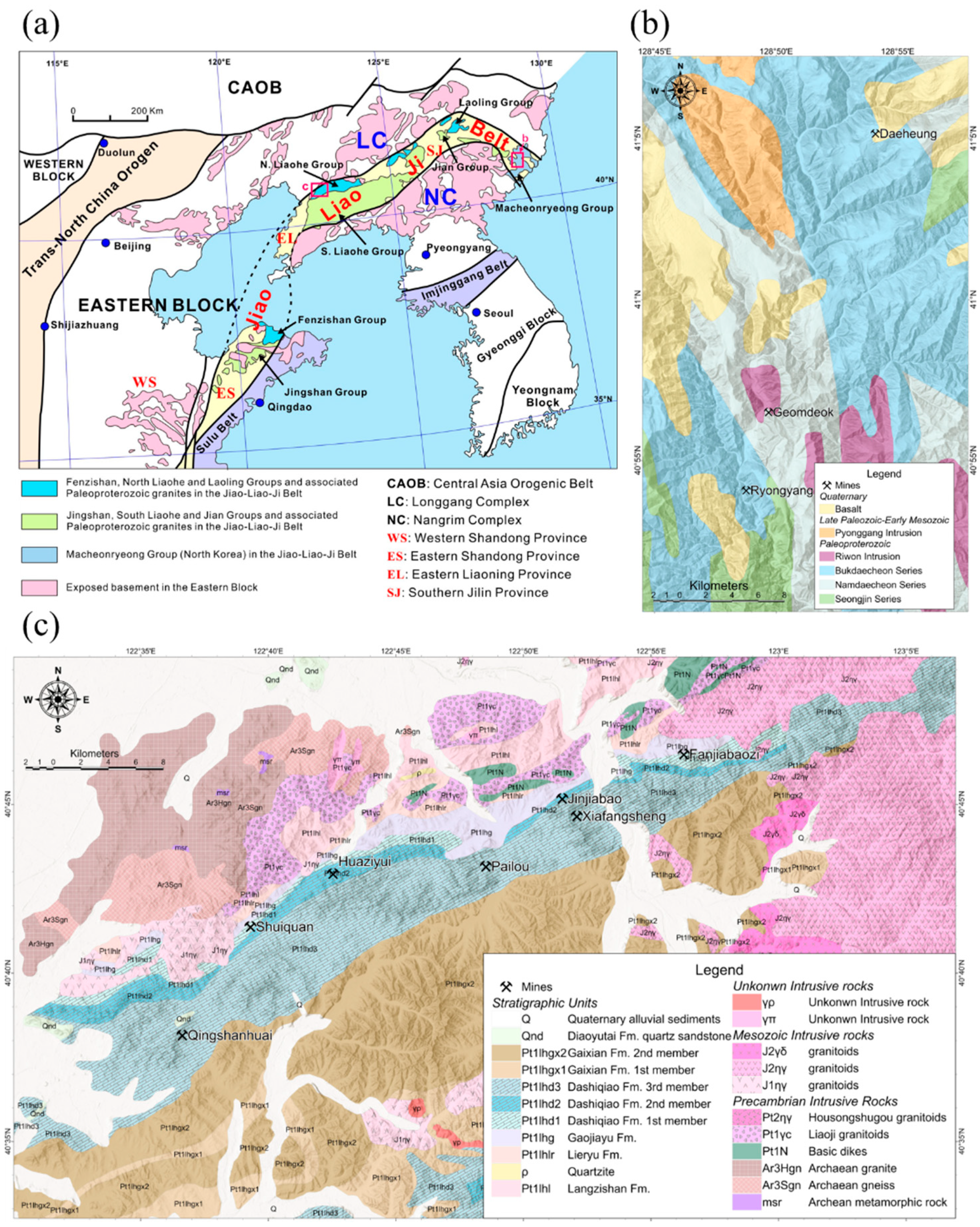
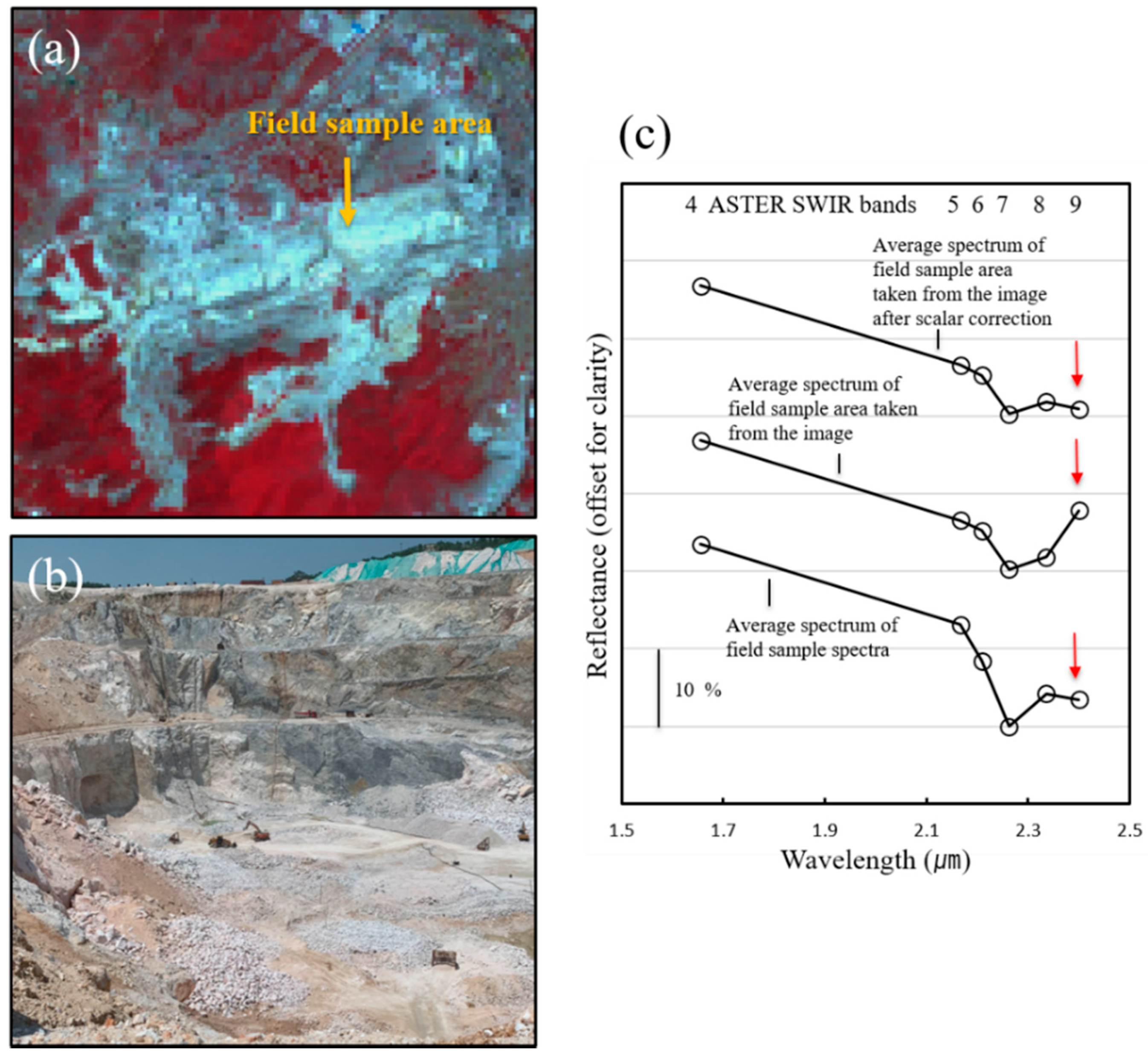


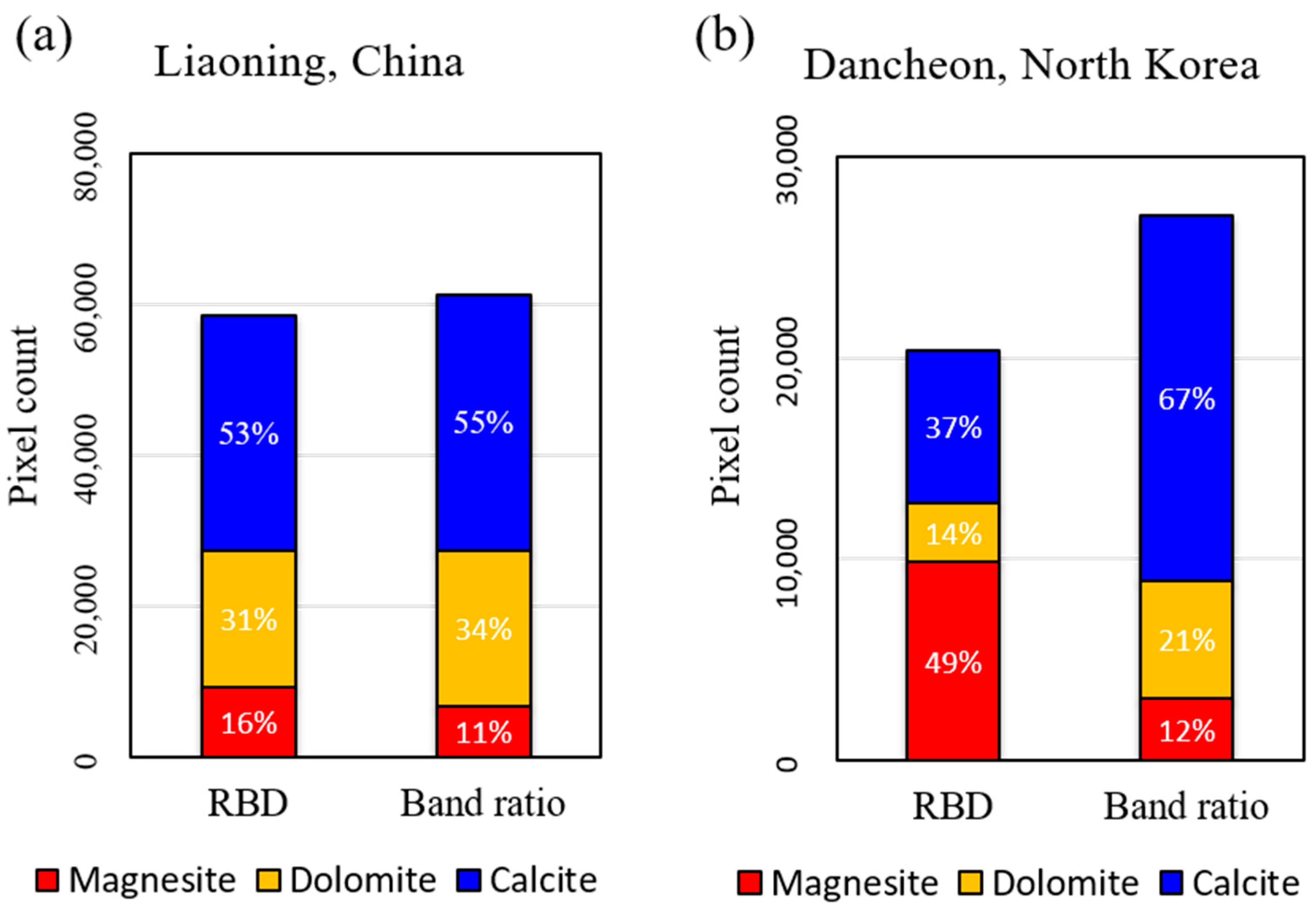
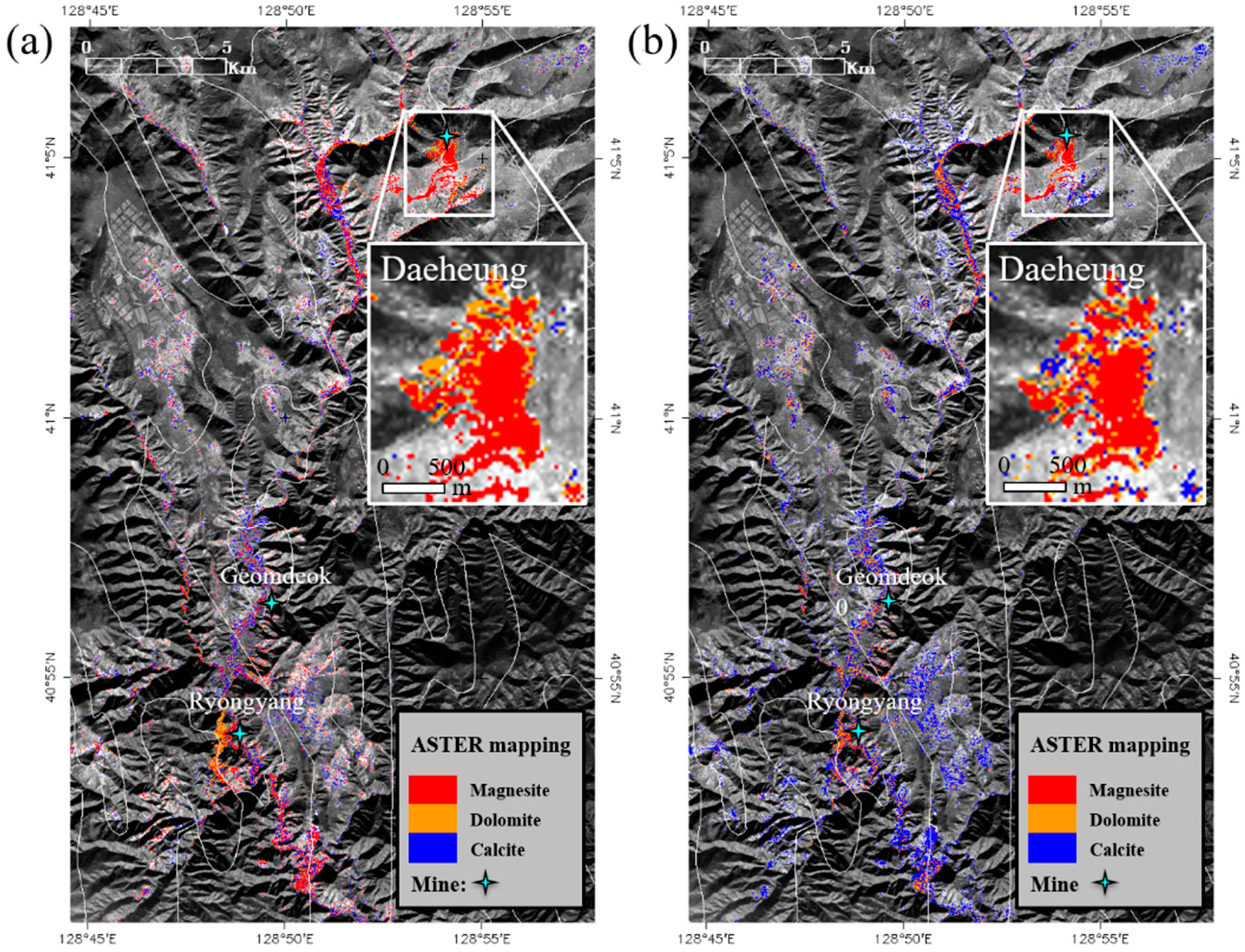

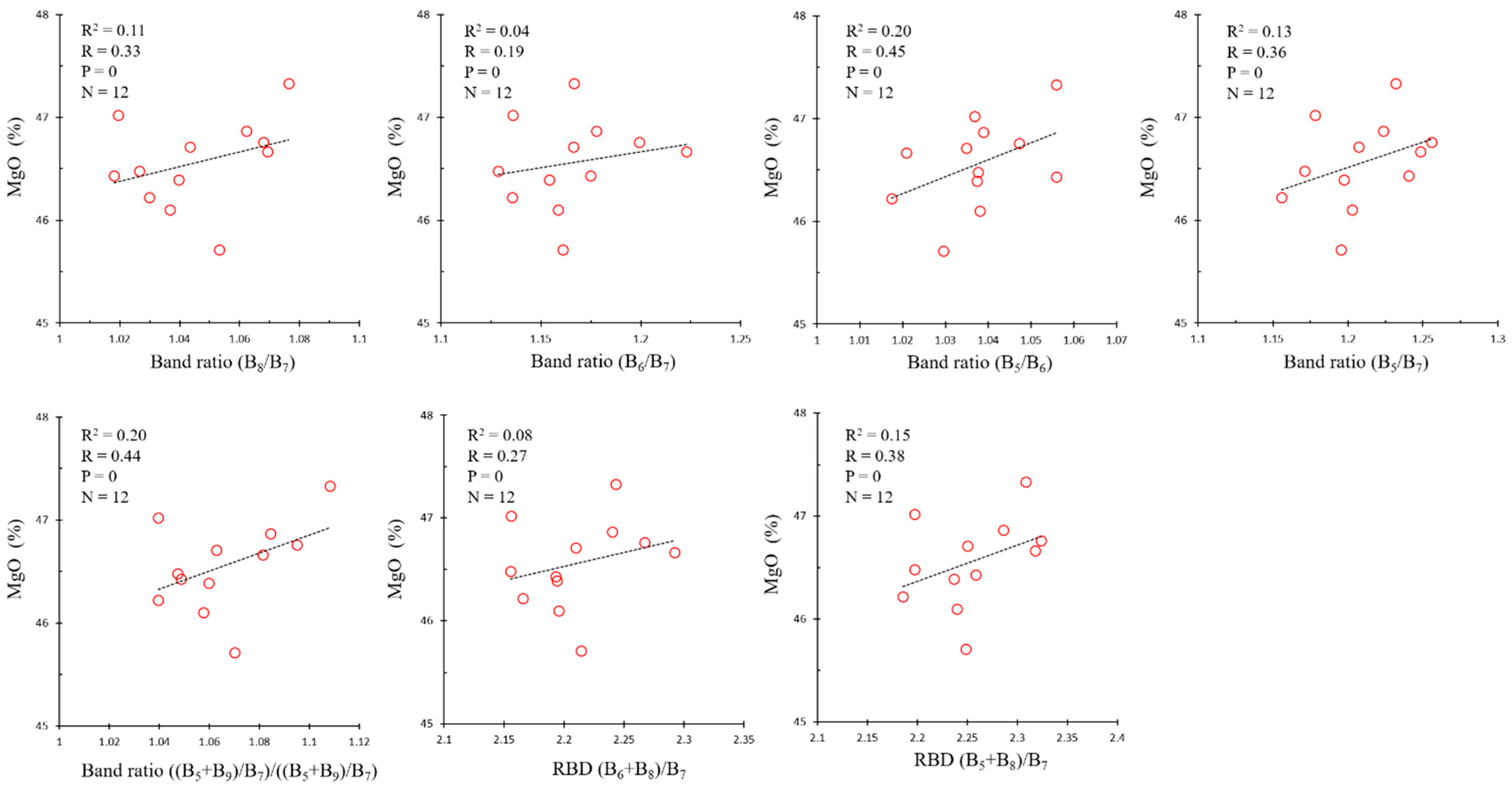

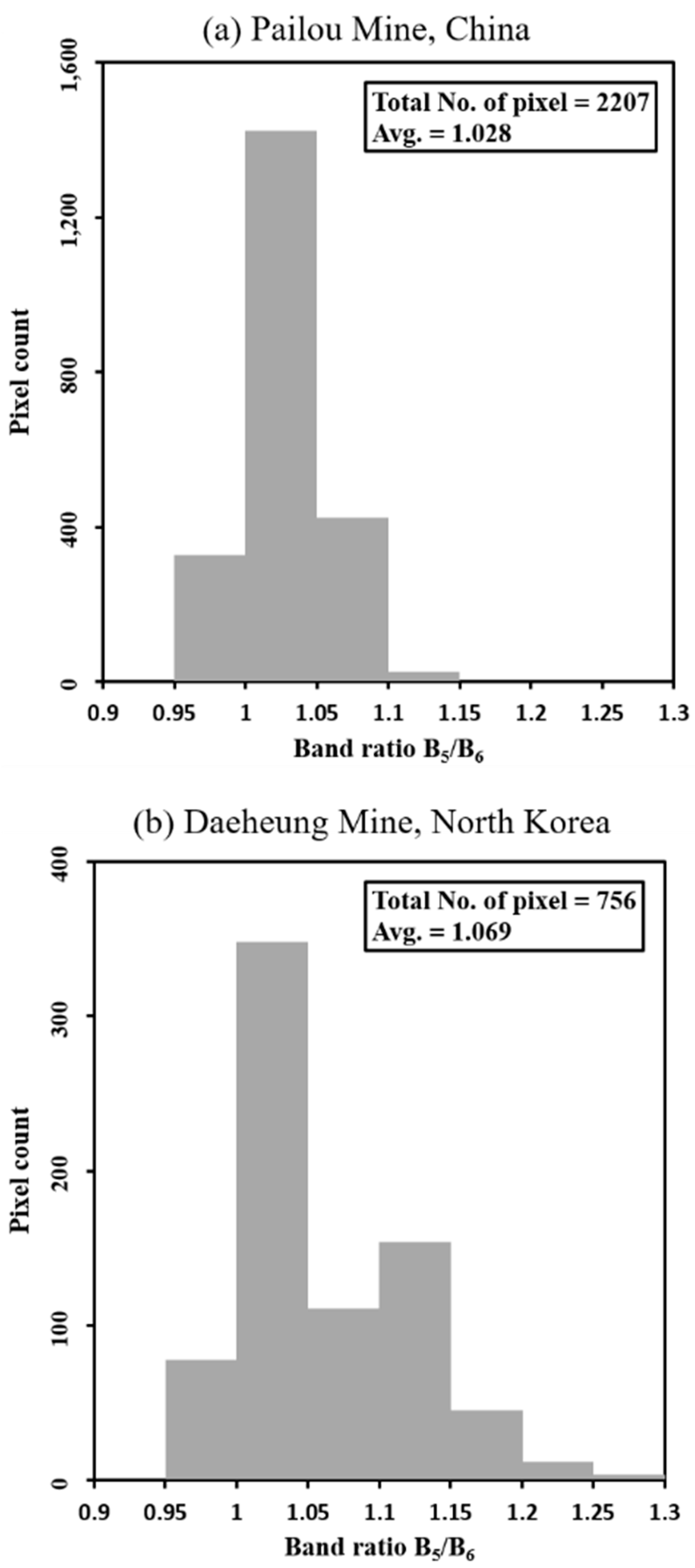
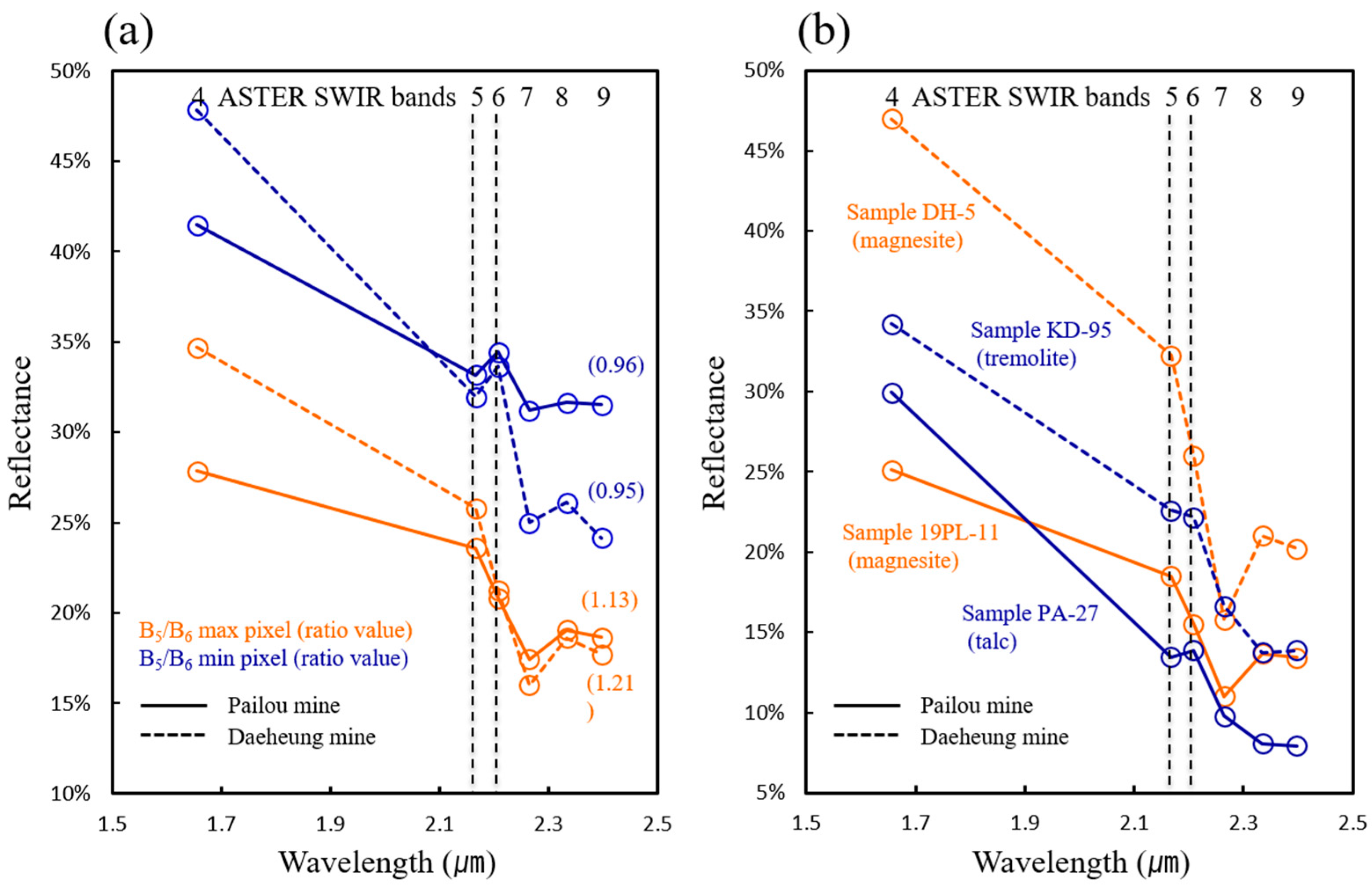
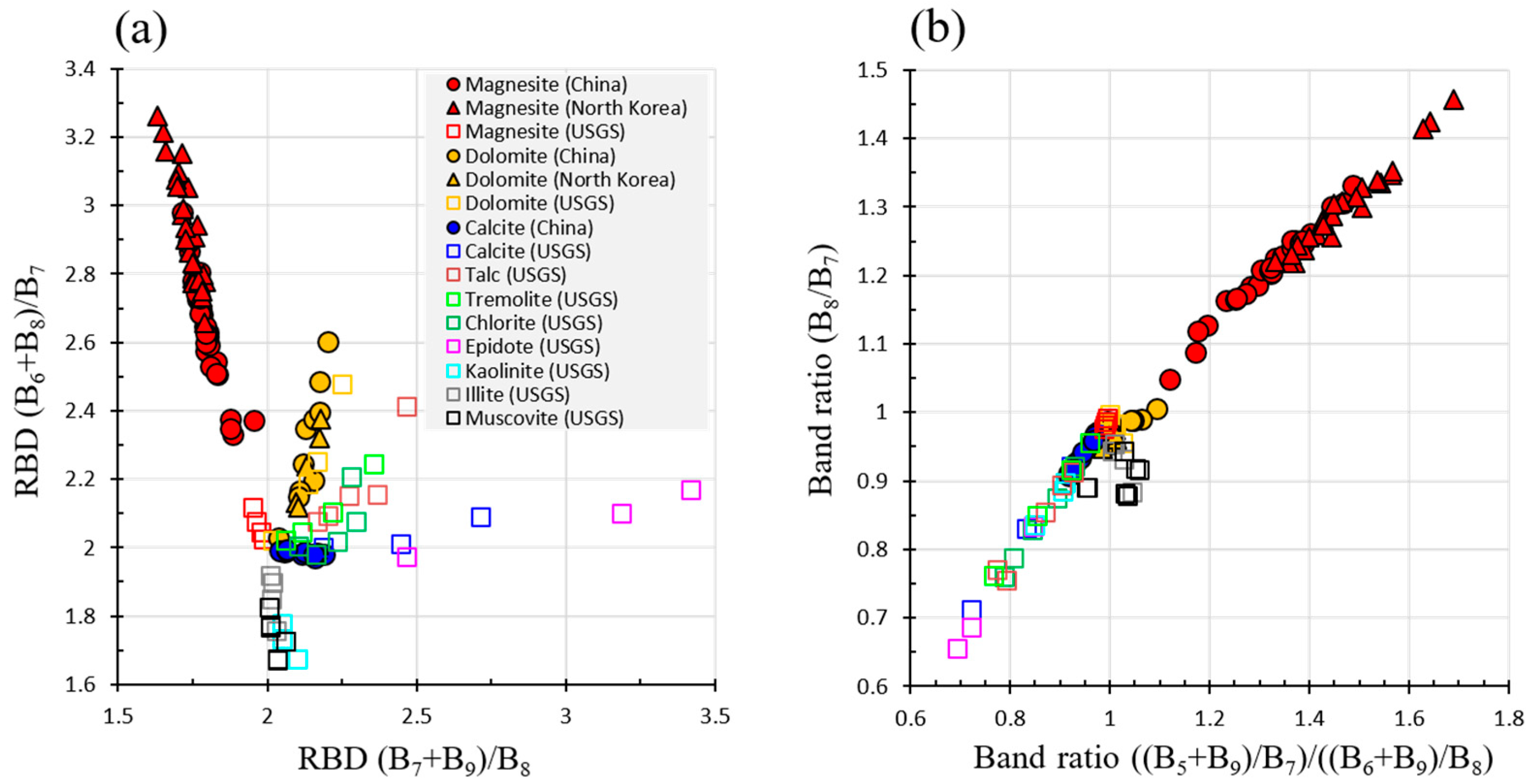
| Study Area | Mineral | Total Number of Samples |
|---|---|---|
| Liaoning, China | Magnesite | 33 |
| Dolomite | 10 | |
| Calcite | 12 | |
| Dancheon, North Korea | Magnesite | 25 |
| Dolomite | 4 |
| Study Area | Acquisition Date |
|---|---|
| Liaoning, China | 16 June 2006 |
| Dancheon, North Korea | 17 November 2006 |
| Target Mineral | Equation and Threshold | Reference |
|---|---|---|
| Calcite | , unknown threshold | [8] |
| ≤ 1.021 | [12] | |
| ≤ 1.012 | ||
| ≤ 1.995 | Proposed in this study | |
| ≤ 0.977 | ||
| Dolomite | , unknown threshold | [8] |
| > 1.021 | [12] | |
| > 1.012 | ||
| > 1.995 | Proposed in this study | |
| > 0.977 | ||
| Magnesite | > 2.13 | Proposed in this study |
| > 1.033 |
| Mine | Number of Rock Sample | MgO Content (in Weight%) | Number of Image Pixel | Band Ratio Value | ||||
|---|---|---|---|---|---|---|---|---|
| Max. | Min. | Avg. | Max. | Min. | Avg. | |||
| Pailou | 38 | 47.33 | 45.21 | 46.43 | 2207 | 1.13 | 0.96 | 1.028 |
| Daeheung | 11 | 48.49 | 47.37 | 47.4 | 756 | 1.21 | 0.95 | 1.069 |
Publisher’s Note: MDPI stays neutral with regard to jurisdictional claims in published maps and institutional affiliations. |
© 2022 by the authors. Licensee MDPI, Basel, Switzerland. This article is an open access article distributed under the terms and conditions of the Creative Commons Attribution (CC BY) license (https://creativecommons.org/licenses/by/4.0/).
Share and Cite
Son, Y.-S.; Lee, G.; Lee, B.H.; Kim, N.; Koh, S.-M.; Kim, K.-E.; Cho, S.-J. Application of ASTER Data for Differentiating Carbonate Minerals and Evaluating MgO Content of Magnesite in the Jiao-Liao-Ji Belt, North China Craton. Remote Sens. 2022, 14, 181. https://doi.org/10.3390/rs14010181
Son Y-S, Lee G, Lee BH, Kim N, Koh S-M, Kim K-E, Cho S-J. Application of ASTER Data for Differentiating Carbonate Minerals and Evaluating MgO Content of Magnesite in the Jiao-Liao-Ji Belt, North China Craton. Remote Sensing. 2022; 14(1):181. https://doi.org/10.3390/rs14010181
Chicago/Turabian StyleSon, Young-Sun, Gilljae Lee, Bum Han Lee, Namhoon Kim, Sang-Mo Koh, Kwang-Eun Kim, and Seong-Jun Cho. 2022. "Application of ASTER Data for Differentiating Carbonate Minerals and Evaluating MgO Content of Magnesite in the Jiao-Liao-Ji Belt, North China Craton" Remote Sensing 14, no. 1: 181. https://doi.org/10.3390/rs14010181
APA StyleSon, Y.-S., Lee, G., Lee, B. H., Kim, N., Koh, S.-M., Kim, K.-E., & Cho, S.-J. (2022). Application of ASTER Data for Differentiating Carbonate Minerals and Evaluating MgO Content of Magnesite in the Jiao-Liao-Ji Belt, North China Craton. Remote Sensing, 14(1), 181. https://doi.org/10.3390/rs14010181





